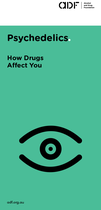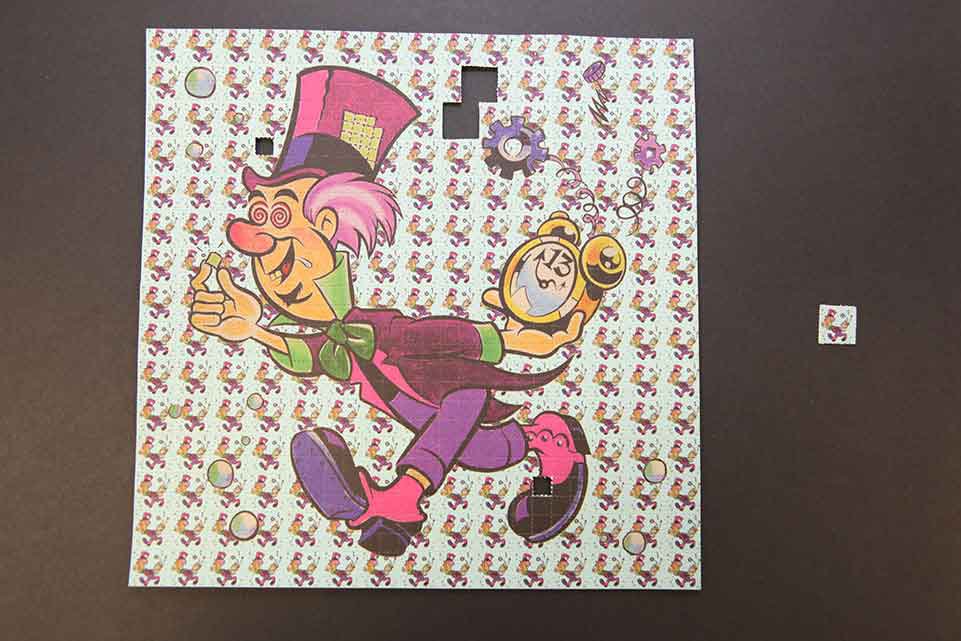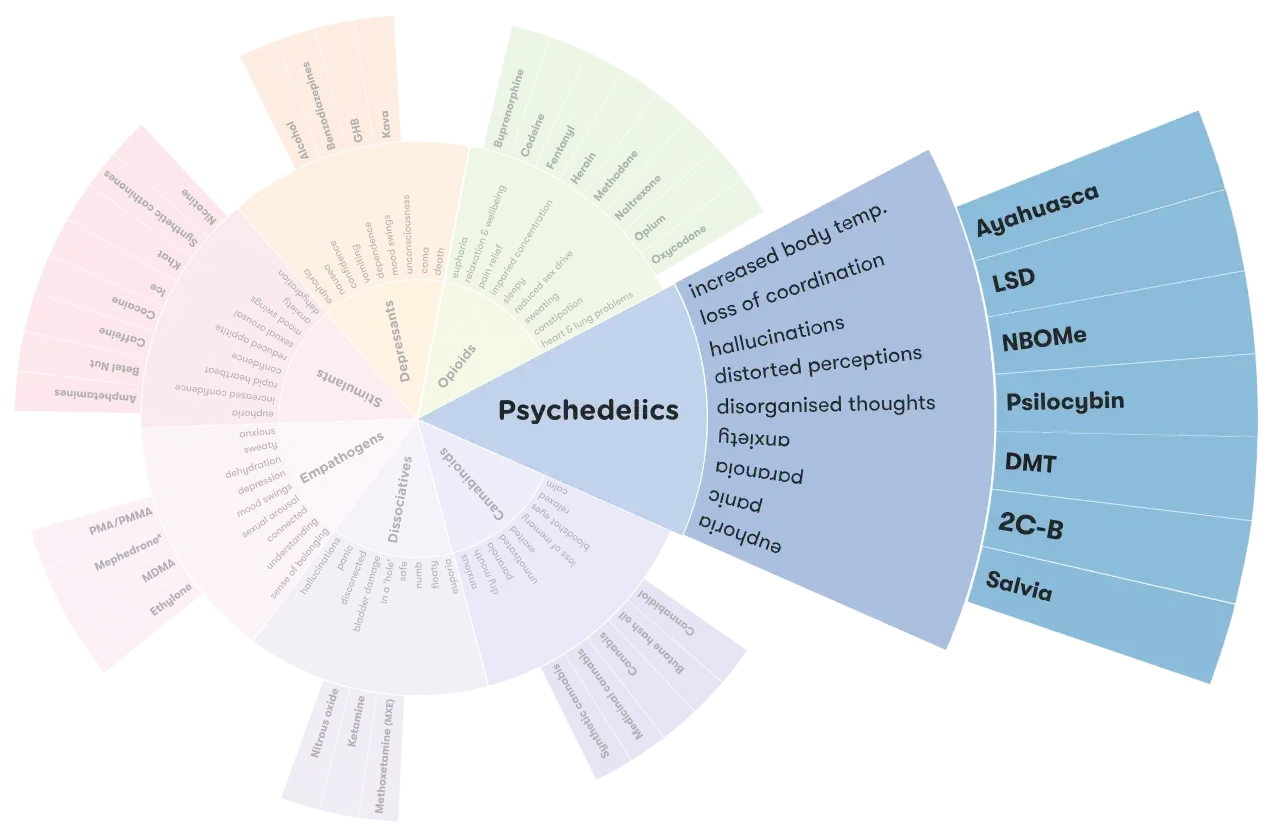
Psychedelics: How drugs affect you (bundle of 50)
Pamphlets
$36.32 (inc. GST)
View in ADF Shop
Effects of LSD
Use of any drug always carries some risk. It’s important to be careful when taking any type of drug.
LSD can affect everyone differently, based on:
- size, weight and health
- whether the person is used to taking it
- whether other drugs are taken around the same time
- the amount taken
- the strength of the drug (varies from batch to batch).
The effects of LSD usually begin in approximately 20-90 minutes and will last around 8-12 hours.7,8
The following may be experienced:
- euphoria and wellbeing
- dilation of pupils
- perceptual changes, such as visual and auditory hallucinations
- confusion and trouble concentrating
- headaches
- nausea
- fast or irregular heartbeat
- increased body temperature
- breathing quickly
- vomiting
- facial flushes, sweating and chills.3,6
Impact of mood and environment
Drugs that affect a person’s mental state (psychoactive drugs) can also have varied effects depending on a person’s mood (often called the ‘set’) or the environment they are in (the ‘setting’):
- Set: a person’s state of mind, previous encounters with psychedelic drugs, and expectations of what’s going to happen. For example, feelings of stress or anxiety before using LSD may result in an unpleasant experience (bad trip).9
- Setting: the environment in which someone consumes LSD – whether it’s known and familiar, who they’re with, if they’re indoors or outdoors, the type of music and light. For example, using LSD in a calm, quiet and relaxed environment can contribute to, a more pleasant experience. However, being in a noisy, crowded place may result in a negative experience.9
- Being in a good state of mind, with trusted friends and a safe environment before taking LSD reduces the risk of having a ‘bad’ trip.10
Overdose
If you take a large amount or have a strong batch, you could overdose.
While LSD overdose deaths have been reported in Australia, most deaths linked to LSD are caused by accidents like falls or car crashes.11
If someone has the following symptoms call an ambulance immediately by dialling triple zero (000), emergency services are there to help and can provide instructions over the phone:
- intense agitation or panic
- paranoia
- increased risk taking
- seizure
- chest pain
- psychosis.3,11
Provide as much information as possible about the drug taken, the amount, timing, any other substances involved, and any pre-existing medical conditions.
Bad trips
A ‘bad trip’ can involve unpleasant or intense hallucinations, as well as feelings of anxiety, paranoia, panic, or other negative emotions.1,12,13
Taking a large dose of psychedelics is the most common cause of a bad trip, but other factors like age, sex, mental state, and past experiences with the drug can also contribute.12-14
It is important to understand the difference between a bad trip and an overdose. While a bad trip can feel frightening, it is generally not life-threatening and the effects will go away as the drug wears off.1,12-14
Coming down
In the following days after using LSD, the following may be experienced:
- insomnia
- fatigue
- body and muscle aches
- feeling depressed.3
Long-term effects
Some people who regularly use LSD may eventually experience flashbacks. This is when an LSD experience reoccurs usually as a visual distortion.
Flashbacks can happen weeks, months or even years after the drug was last taken. Flashbacks can be disturbing, especially if a frightening experience or hallucination is recalled.3,6
Flashbacks can be brought on by stress, tiredness, exercise or using other drugs. They usually last for a minute or two.6
LSD and Mental Health
Using LSD can trigger or worsen mental health conditions such as anxiety, schizophrenia or psychosis.3,6 Anyone with a history of these issues should avoid using LSD.
However, research into the administration of LSD in a safe, therapeutic setting, involving a controlled dose, has shown positive results in treating depression, post-traumatic stress disorder, and reducing anxiety in patients with a life-threatening disease.15
Read more about some of this research here.
Tolerance and dependence
Tolerance develops rapidly to the effects of LSD. After the third or fourth consecutive days of taking LSD, the drug won’t produce the desired effects. However, after a period of abstinence (about three to four days), tolerance should return to normal.6
When people develop a tolerance to LSD, the usual dose of other psychedelics also becomes ineffective. This is known as cross-tolerance and is commonly observed with psilocybin, LSD, and mescaline.16
Mixing LSD with other drugs
Mixing LSD with other drugs can have unpredictable effects and increase the risk of harm.
- LSD and alcohol: can cause nausea, vomiting, can impact the desirable effects of LSD.
- LSD and ketamine: these drugs can work together to increase their effects.
- LSD and MDMA: these drugs can work together to increase both of their effects, creating a more intense psychedelic experience.
- LSD and cannabis: can increase unpredictable and negative effects. In rare cases psychosis.
- LSD and cocaine: can increase anxiety, paranoia, thought loops.
- LSD and methamphetamine (ice): can increase anxiety, paranoia and thought loops.
- LSD and nitrous oxide (nangs): can cause intense dissociation, or risk of a short negative psychedelic experience.
- LSD and psilocybin: these drugs can work together to increase effects, creating a more intense or negative psychedelic experience.8
Use of more than one drug or type of drug consumed at the same time is called polydrug use.17
More on Polydrug use
Polydrug use is a term for the use of more than one drug or type of drug at the same time or one after another. Polydrug use can involve both illicit drugs and legal substances, such as alcohol and medications.
Reducing harm
- If the tab has a bitter taste, discard immediately as it likely not LSD. It could be a more harmful substance such as NBOMe which is often sold as LSD
- Use in a safe environment with people you trust
- Consider the impact of your mood and the environment you’re in
- If you’re not feeling good - physically or mentally - it is best not to take LSD as these feelings may intensify
- Don’t drive, operate machinery or swim
- Having a sober friend with you is recommended, especially if it is your first time using LSD.8
‘Trip sitting’ is when a sober person helps look after someone who’s taken a psychoactive drug, usually psychedelics like LSD or psilocybin. Research has shown that having a trip sitter is one of the most effective harm reduction measures for psychedelic drugs like LSD.12,18
Find out more about trip sitting.
Withdrawal
There are no known physical withdrawal symptoms of LSD. Taking LSD regularly does not result in physical dependence. While there have been reports of psychological dependence, the evidence is limited.3,6
Getting help
If your use of LSD is affecting your health, family, relationships, work, school, financial or other life situations, or you’re concerned about someone else, you can find help and support.
- Call the National Alcohol and Other Drug Hotline on 1800 250 015 for free and confidential advice, information and counselling about alcohol and other drugs
- Help and support services search
Find a service in your local area from our list. Simply add your location or postcode and filter by service type to quickly discover help near you.
If you’re looking for other information or support options, send us an email at druginfo@adf.org.au
Path2Help
Not sure what you are looking for?
Try our intuitive Path2Help tool and be matched with support information and services tailored to you.

Australian Federal and State laws provide penalties for possessing, using, making or selling LSD, or driving under the influence.
See also, drugs and the law.
- 12.2% of Australians aged 14 years and over have used psychedelics one or more times in their life.19
- 2.4% of Australians aged 14 years and over have used psychedelics in the previous 12 months.19
- 61.6% of people who had recently used psychedelics reported using LSD.19
- On average young Australians (aged 14–29) first try psychedelics at 21 years of age.20
- Nichols D. Psychedelics. 2016 [cited 12.01.2021]
- Marshman JA, Brands B, Sproule B, Jacobs MR. Drugs & drug abuse: a reference text. Toronto: Addiction Research Foundation; 1998 [cited 26.11.2024].
- Campbell A. The Australian Illicit Drug Guide: Every Person's Guide to Illicit Drugs--Their Use, Effects and History, Treatment Options and Legal Penalties. Black Inc; 2001 [cited 26.11.2024].
- Poulie CBM, Jensen AA, Halberstadt AL, Kristensen JL. DARK Classics in Chemical Neuroscience: NBOMes. ACS Chemical Neuroscience. 2020; 11(23):3860-9. [cited 29.10.2024]
- Suzuki J, Dekker MA, Valenti ES, Arbelo Cruz FA, Correa AM, Poklis JL, et al. Toxicities associated with NBOMe ingestion-a novel class of potent hallucinogens: a review of the literature. Psychosomatics. 2015; 56(2):129-39. [cited 29.10.2024]
- Brands B, Sproule, B & Marshman, J, editor. Drugs & drug abuse. 3rd ed. Ontario: Addiction Research Foundation; 1998.
- Black E, Bruno R, Shakeshaft A, Newton N et al. Hallucinogens: What you need to know. UNSW Sydney: National Drug and Alcohol Research Centre; 2014. [cited
- Hi-Ground. LSD n.d. [cited 30.11.2022]
- Nutt D. Drugs without the hot air : making sense of legal and illegal drugs. Cambridge: UIT Cambridge Ltd; 2012 [cited 26.11.2024].
- Palmer M, Maynard OM. Are you tripping comfortably? Investigating the relationship between harm reduction and the psychedelic experience. Harm Reduct J. 2022; 19(1):81. [cited PMC9310449]
- Darke S, Duflou J, Peacock A, Farrell M, Hall W, Lappin J. A retrospective study of the characteristics and toxicology of cases of lysergic acid diethylamide (LSD)- and psilocybin-related death in Australia. Addiction. 2024; 119(9):1564-71. [cited 11.10.2024]
- Gashi L, Sandberg S, Pedersen W. Making "bad trips" good: How users of psychedelics narratively transform challenging trips into valuable experiences. Int J Drug Policy. 2021;87:102997. [cited 06/08/2024]
- Simonsson O, Hendricks PS, Chambers R, Osika W, Goldberg SB. Prevalence and associations of challenging, difficult or distressing experiences using classic psychedelics. J Affect Disord. 2023; 326:105-10. [cited 26.09.2024]
- Studerus E, Gamma A, Kometer M, Vollenweider FX, Mazza M. Prediction of Psilocybin Response in Healthy Volunteers. PLoS ONE. 2012; 7(2). [cited [06/08/2024] Available from:
- Liechti ME. Modern Clinical Research on LSD. Neuropsychopharmacology : official publication of the American College of Neuropsychopharmacology. 2017;42(11):2114-27.
- Korsmeyer P, Kranzler HR. Lysergic Acid Diethylamide (LSD) and Psychedelics. Encyclopedia of Drugs, Alcohol & Addictive Behavior, . 2009; 2:372-8. [cited 29.10.2024]
- Darke S, Lappin, J. & Farrell, M. The Clinician's Guide to Illicit Drugs. United Kingdom: Silverback Publishing 2019 [cited 26.11.2024].
- Heyl JC. What Does a Trip Sitter Do?2022 [cited 06/08/2024]
- Australian Institute of Health and Welfare. Data tables: National Drug Strategy Household Survey 2022–2023 – 5. Illicit drugs: Table 5.97. 2024
- Australian Institute of Health and Welfare. National Drug Strategy Household Survey 2022–2023: Hallucinogens in the NDSHS. 2024 [cited 17.10.2024]

